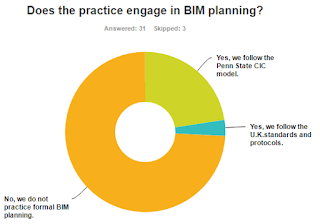Colleagues,
Thanks again to all who attended the October SCRUG meeting. Thanks to LPA and our host Alejandro Lopez, and to our sponsors Kelar, Microdesk and U.S. CAD.
The survey will remain open for collection of additional data. To participate follow the link above.
Survey results are also published and available for members' review. A big surprise to me was the revelation that three-fourths of the firms surveyed do not practice BIM planning:
The Future of SCRUG...
In addition to reviewing the results of the survey, attendees were invited to discuss ideas to re-invigorate the group and provide more value for members.
One of our challenges is the broad range in the application of BIM technology among members. Different markets, design disciplines, and firm dynamics. From sole practitioners to the multi-office national design leaders - we have them all. These differences should strengthen, not weaken, the group.
Having been on the "bleeding edge" of technology change for more than three decades, I believe this is the most exciting time ever. New technologies and increased computational power provide new business opportunities, and innovators will rise to fulfill them.
Futurist Ray Kurzweil suggests that the progress of the entire 20th century would have been achieved in only 20 years at the rate of advancement in the year 2000. Because of the Law of Accelerating Returns, Kurzweil believes that the 21st century will achieve 1,000 times the progress of the 20th century.
3D building modeling has been around for thirty years. Computational design is in its infancy. Artificial Intelligence is on the horizon. How will this impact you? Largely due to the UK BIM Initiative, there is a global trend toward unification of standards for BIM. These are some of the issues that are worthy for discussion across the entire group membership, regardless of distinctions. The future of the group will be shaped by all.
Our next event will be a holiday season celebration in early December. Stay tuned.
Allen Jay Holland
Chairman
Thanks again to all who attended the October SCRUG meeting. Thanks to LPA and our host Alejandro Lopez, and to our sponsors Kelar, Microdesk and U.S. CAD.
The survey will remain open for collection of additional data. To participate follow the link above.
Survey results are also published and available for members' review. A big surprise to me was the revelation that three-fourths of the firms surveyed do not practice BIM planning:
The Future of SCRUG...
In addition to reviewing the results of the survey, attendees were invited to discuss ideas to re-invigorate the group and provide more value for members.
One of our challenges is the broad range in the application of BIM technology among members. Different markets, design disciplines, and firm dynamics. From sole practitioners to the multi-office national design leaders - we have them all. These differences should strengthen, not weaken, the group.
 |
| The Artificial Intelligence Revolution Wait But Why |
Futurist Ray Kurzweil suggests that the progress of the entire 20th century would have been achieved in only 20 years at the rate of advancement in the year 2000. Because of the Law of Accelerating Returns, Kurzweil believes that the 21st century will achieve 1,000 times the progress of the 20th century.
3D building modeling has been around for thirty years. Computational design is in its infancy. Artificial Intelligence is on the horizon. How will this impact you? Largely due to the UK BIM Initiative, there is a global trend toward unification of standards for BIM. These are some of the issues that are worthy for discussion across the entire group membership, regardless of distinctions. The future of the group will be shaped by all.
Our next event will be a holiday season celebration in early December. Stay tuned.
Allen Jay Holland
Chairman


Comments
Post a Comment